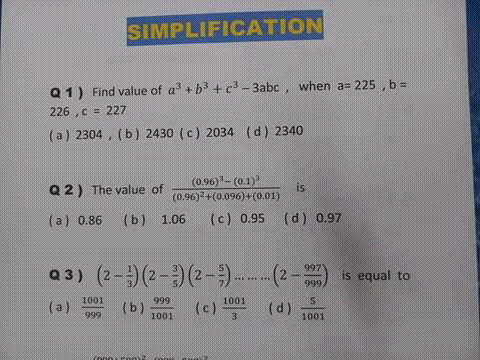
Question and Answers Forum
OthersQuestion and Answers: Page 90



|
Question and Answers Forum |
OthersQuestion and Answers: Page 90 |
| An element X has RAM of 88g.when a current of 0.5A was passed through fused chloride of X for 32minutes and 10sec. 0.44g of X was deposited at the cathode (a)number of faraday? (b)write formular of X ions (c)write the formular of OH |
| calculate W_n = ∫_0 ^(π/2) cos^n xdx ( n from N) and J_n =∫_0 ^(π/2) sin^n xdx |
| prove that ∫_0 ^∞ e^(−t) ln(t) dt =−γ ( γ is the constant of euler) |
| The Most Beautiful Equation for me is: e^(iπ) +1=0 INCREDIBLE! #Euler′sIdentity |
| How many real root does the equation x^8 − x^7 + 2x^6 − 2x^5 + 3x^4 − 3x^3 + 4x^2 − 4x + (5/2) = 0 has |
| M_(TP) =Q(D/Z) × f_ |
| if the point A B C with position vector (20i^ +λj^ ) (5i^ −j^ ) and(10i^ −13j^ ) are collinear then the value of λ is: |
| 6+5>3×5 true or false |
| Given that (1+(√(1+x)))tan x=(1+(√(1−x))). Then find sin 4x. |

|
| 3no_2 +h_2 o⇒2hno_3 +no |
| Correct me if I am wrong. Σ_((√(−1))=1) ^3 x_(√(−1)) +y_(√(−1)) ∴(i=(√(−1))) |
| the 2 and 3 term of GP is 24 and 12(x+1).If the sum of the first 3 terms is 76.Find the value of x |
| Find all solutions of x^3 − 12x + 8 = 0 |
| 1+iw+(iw)^2 +(iw)^3 +.........(iw)^(989) =? ans= (2/(1−iw)) answer is correct. pls help .. how to do this? TIA |
| let V be a vector space and let H and K be subspace of V. show that , H+K={x:x=h+k, where h∈H and k∈K} is a subspace of V. |
| consider the triple of real numbers (x,y,z) defined by the addittion (x,y,z)+(x′,y′,z′)=(x+x′,y+y′,z+z′) and scalar multiplication by 𝛂(x,y,z)=(0,0,0). Show that all axioms for a vector space are satisfied except axiom 8. |

|
| if f(z)=Σ_(k=1) ^n a_k z^k ,a_k ,z∈C.Prove a_k =(1/(2πi))∫_(∣z∣=r ) ((f(z))/z^(k+1) )dz |
| 3xy^2 +x^3 =9 −−−−−(1) 3x^2 y+y^3 =18−−−−(2) Find x and y |
| let f(x) =e^(−ax) arctan(3x) with a>0 1) calculate f^((n)) (x) and f^((n)) (0) 2) developp f (x) at integr serie . 3) calculate ∫_0 ^∞ f(x)dx . |
| 1+(1/(1+(1/(1+(1/(1+(1/(1+(1/(1+...))))))))))= |
| S_1 =Σ_(k=1) ^n (√((16n−16k)(16n+16k))) S_2 =Σ_(k=1) ^n (√((16k−16)(16k+16))) lim_(n→∞) ((S_1 +S_2 )/n^2 )=? |

|
| Solve the differential equation: (dy/dx) = x^2 + y^2 |